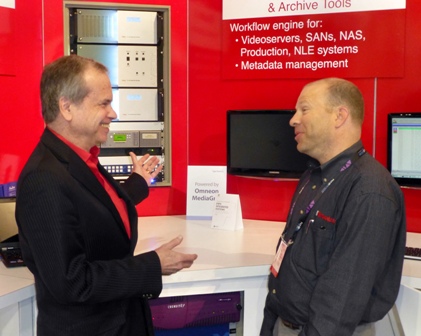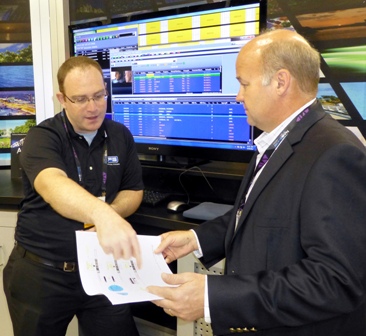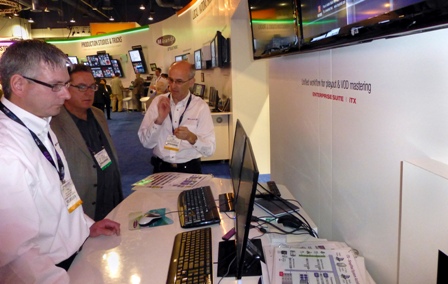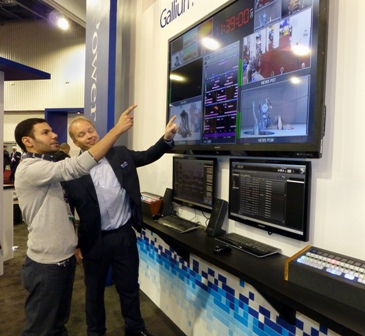Automation at the 2012 NAB Show
Automation has evolved far beyond its play-to-air roots; in one form or another, it’s integral to managing and distributing digital media. Channel appliances—those self-contained systems in a box or rack—are everywhere, but still struggle for station-level acceptance. Mainstream automation is being assimilated into high-level asset lifecycle and media monetization workflows, some incorporating elements of Service Oriented Architecture and Business Process Management.

Roger Crooks (L) of Aveco shares a laugh with Tony Roccanova of 5280 Broadcast in front of the Aveco Astra automation, master control and production system.AUTOMATION
Aveco debuted a scalable Disaster Recovery solution; Regional Ad Insertion for Hub & Spoke or Centralized architectures; and ASTRA Studio 2, enabling solo operator’s to create complex newscasts and programs. Aveco also unbundled key workflow tools as standalone apps, including Content Management and Archiving.
Crispin introduced a dynamic Auto-Failover Switch to protect mixed serial and TCP/IP control systems; Web-based DigiPrep to frame-accurately trim, time and quality-check media via lo-res proxies. Also new: subscription-based Cameo (single-channel) and Veranda (multistream) master control/asset management solutions, plus BXF Service 3.0 with support for WideOrbit traffic.
Digital Broadcast showcased its new Spot Commander, a hosted Website solution for station clients to submit ads.
Evertz powered-up its Mediator content management and automation with an integrated new GUI, tools for VOD preparation and distribution, plus a workflow editor tool to customize tasks and processes. Mediator RT LIVE gained auto join-in-progress with content dead-roll, live break insertions without playlist alteration, a new graphics workflow with integrated templates, and separate playlists for opportunistic availabilities.

George Nalen (L) of Florical Systems pitches the company's Acuitas channel-in-a-box solution to Al Domescik of WVUE.Florical enhanced Acuitas, its scalable IT station-in-a-box solution with automation functionality shared with standalone AirBoss. It offers HD playout, graphics, effects and frame-accurate switching for basic commercial insertion or multichannel operations.
Grass Valley introduced K2 Edge, a Linux-based, multichannel automated playout series available as entry-level Express, Pro for primary channels; and Elite with up to four switched HD sources, plus multichannel 2/3D graphics with DVE.
Harris unveiled its Magellan Network Management System (NMS) for centralized monitoring and control across multiple channels/facilities via a consolidated user interface. V4.0 of Invenio Motion expands on its digital resource management functionality, adding an SOA layer to optimize media asset and D-Series/ADC automation workflows.

Phil Sheppard (R) and Ian Fletcher (L) of Miranda give a presentation on the Enterprise Suite on-demand automation system to Mark Gleeson of Sony Pictures.Miranda Technologies rolled-out iTX MC, a fusion of the company’s integrated playout platform with its traditional master control technologies to offer stations, networks and sports broadcasters a solution combining playout automation with live event functionality, enhanced switching and familiar manual controls. The iTX series also added graphics capability with Miranda’s realtime Vertigo XG processor on-board and a deep integration of Adobe After Effects for dynamic, just-in-time rendering. The company also launched Enterprise Suite On-Demand, a publishing system to automate content workflows for linear and on-demand media; available as a standalone or iTX add-on.
Nverzion showed CLASS (Component Level Automation System Solutions), an alternative to single-box broadcast solutions that works with legacy hardware/software under a unified platform.
Pebble Beach Systems added subtitling and 3D graphics to its Dolphin Station-in-a-Box. Marina Automation, the company’s next-gen Enterprise solution for content capture, management and delivery across multiple channel types, added Extended Media Validation for aspect ratio, language, audio type, etc.; interfaces to Avid Interplay and other asset managers; plus dynamic resource reporting, management and allocation capabilities.

Osama Kotb of Al-Hayat TV in Egypt and James Gilbert of Pixel Power discuss the Pixel Power Gallium graphic-centric automation system.Pixel Power introduced Gallium, its new integrated scheduling, asset management and automation system for playout facilities that need automated control of Pixel Power transmission devices, including ChannelMaster, for graphics or complete channel playout. Gallium manages delivery of multiformat content for web, mobile, and IPTV applications.
Primestream (formerly Building4Media), introduced its FORK Xchange Suite, a collaborative Web application fully integrated with the company’s FORK Production Server. It offers instant access to media from any PC, Mac or iOS device. Users can browse, add metadata and markers, trigger FORK action scripts, and transfer media to/from multiple remote servers.
Rushworks debuted A-Zone, a multizone display engine with remote management and PowerPoint-driven content for secondary channels and digital signage; it supports SD/HD playback, RSS feeds and optional live inputs.
Snell featured v3.0 of its ICE Channel-in-a-Box with integrated 3D graphics and timeline controlled CG functionality, plus the ability to populate fields from the company’s Morpheus automation schedule, as well as external data sources. Also new was a high-performance SAN storage option. Morpheus automation added second-screen capabilities and other tools to help broadcasters monetize their assets. Also debuted was Momentum, which offers sophisticated workflow automation, plus resource and asset management via a unified interface to perform complex tasks across multiple departments and staffs.
WideOrbit launched Native BXF Live Log integration between its WO Master Control—up to 16 channels of HD/SD with integral switching, graphics, automation and content storage in a single rack—and the company’s WO Traffic suite.
ARCHIVING & ASSET MANAGEMENT
AmberFin debuted iCR Unified QC with multiple tools for baseband checks during tape ingest, file-based after ingest QC, and operator-controlled QC, including annotation and mark-up; plus, added support for third-party QC systems. New iCR Player offers HD/SDI output for broadcast grade monitoring; an optional plug-in for iCR, all video, audio, closed caption and ancillary data properties can be monitored via its user interface.
Avid emphasized asset-based environments, adding industry-standard Business Process Management tools to Interplay MAM v4; also Drag & Drop-ability between it and content creation workflows. New Interplay Sphere lets news professionals acquire, access, edit and finish stories anywhere, anytime. iNEWS Command v3 added iPad support, among other enhancements.
Dalet Digital Media Systems unveiled Galaxy, an advanced MAM offering with an updated GUI, built-in Dalet One Cut multitrack video editor, customizable data models, sharpened search and indexing tools, and greater NLE interoperability.
Front Porch Digital introduced its LYNX product family, a cloud-based content storage management (CSM) environment for global asset management from any device or location. DIVAdirector v5.0 adds asset management versatility, including HTTP-based adaptive streaming for dynamic switching between video/audio bit rates based on network conditions and CPU power. V7.0 of DIVArchive debuted with AXF support, plus a new GUI and dashboards.
Masstech launched DIAMOND, a set of low-cost workflow and interoperability apps in a portal version for Avid and FCP or as standalones. Also new, Emerald v7.5LE with LTO tape support, HQS transcoding, and efficient file-based archiving. It features HSM archiving, a MOS interface to iNEWS and AP-ENPS, plus Apple and Avid interfaces.
Pilat Media’s expanded Rights solution, a key component of its Integrated Broadcast Management System (IBMS), adds customer-defined, multilevel rights management to support a wide range of delivery platforms and interactive services.
SGL showed its Web-based Flash Browse v3 and demonstrated full LTFS support in FlashNet archive manager, enabling it to write AS02-wrapped files to an LTFS-compliant tape with all descriptive file data intact so that video, audio and metadata can be transported to any destination.
Signiant featured Media Shuttle, subscription and cloud-based file sharing software for media movement.
Telestream demonstrated Vantage Transcoding v4 with advanced 16-bit video processing, improved up/down/cross conversion, x264 and AS02 encoding, and more. Vantage Workflow added CALM Act compliant loudness measurement and correction, closed captioning for Internet-delivered video, and Web workflow portals; advanced parallel processing enable Vantage LightSpeed to boost video throughput.
NEWSROOM AUTOMATION
Bitcentral unveiled Create v2, a wide-area collaborative workflow for producers, writers and editors to log, edit and publish content from anywhere. Features include browser-based encoding, discrete 2-channel audio with “rubber band” level control and simultaneous edit while encoding. Also new: Wellspring, a cloud-based or local archiving, back-up and disaster recovery solution.
EVS brought End-to-End News, a combination of IT and live broadcast functionalities to satisfy news production needs for speed, scalability and openness.
V6.2 of Grass Valley’s Ignite added multisuite Karrera Konnect and a MOS Portal to filter changes from the newsroom computer.
Ross Video debuted Inception, a social media toolkit to help stations connect with their audience by creating, scheduling and managing newsroom or promo content. Also new: QuickTurn, a workflow to concurrently create web and broadcast streams, and v12 of the OverDrive Automated Production Control System. New redundancy options: HotSwap between servers, DeviceSwap to sync roll video, and FrameSwap for two Vision switchers to run synchronously.
TRAFFIC & BUSINESS MANAGEMENT
BroadView Software offered greater flexibility and reduced IT overhead with BroadView Cloud (BVC), its seventh-generation integrated traffic and sales management suite.
Harris augmented OSi Traffic with Net Gain Business Analytics, adding dashboards and email/mobile device support; campaign approval by mobile app (Android, Apple or BlackBerry); and advanced advertising capabilities for VOD and mobile.
ProTrack TV, Myers Information Systems' BXF-enabled flagship showed enhanced traffic, content, scheduling and sales management tools for individual, multichannel and multistation broadcasters.
Enterprise resource manager ScheduALL debuted its Chorus interoperability platform. Using industry-standard protocols to communicate with third-party media workflows, it drives routers, ingests to MAM or DAM systems, delivers data to content movers, talks to financial systems, etc.
StorerTV launched Rights Tracker, a scalable web-enabled software suite with versions to help content owners, producers and distributors manage inventory, sales and royalties for all content and formats.
Volicon's newest iteration of Observer TS, transport stream logging and monitoring system adds input types, including ASI, QAM, 8-VSB, and DVB-T MPEG TS; also, greater system density for HD/SD and easier-to-use interfaces. New Observer Mobile offers iPad or iPhone access to ensure quality, compliance, and communication within the media enterprise.
WideOrbit introduced WO Mobile, targeting mobile programming and campaigns using SMS alerts, MMS videos, sweepstakes and mobile coupons; WO Network, an enterprise sales, traffic and program management solution for cable; and WO Analytics, turnkey Business Intelligence integrated with WO Traffic via easy-to-use data dashboards for mission-critical decision making.
The professional video industry's #1 source for news, trends and product and tech information. Sign up below.
